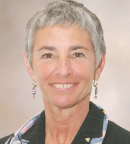GUEST EDITOR

Jamie H. Von Roenn, MD
Addressing the evolving needs of cancer survivors at various stages of their illness and care, Palliative Care in Oncology is guest edited by Jamie H. Von Roenn, MD. Dr. Von Roenn is ASCO’s Vice President of Education, Science, and Professional Development.
Because cultural origins influence the way patients and health-care providers think about palliative and end-of-life care, discussions around these issues should take into account how patients’ cultural and spiritual beliefs and traditions may impact their health-care decisions not just at the end of life, but from the time of a cancer diagnosis and throughout survivorship as well, according to Emily A. Haozous, PhD, RN, FAAN, PhD Program Director and Associate Professor at the University of New Mexico College of Nursing in Albuquerque.
“Culture is the lens through which we experience our lives, so it makes sense a person’s cultural heritage will influence how that person hears a cancer diagnosis, how he interacts with the health-care system, and what he expects from the health-care system,” said Dr. Haozous. “We know racial and ethnic minorities experience persistent health-care disparities in our medical system, and those disparities extend into palliative and end-of-life care as well.”
CULTURAL HUMILITY VS COMPETENCY
Cultural humility acknowledges limited knowledge about another culture. Cultural competency implies a thorough knowledge about the mores of another culture.
To ensure oncologists provide high-quality and effective palliative or end-of-life care to minority patients, it is important to understand and practice cultural humility, which acknowledges limited knowledge about another culture, rather than cultural competency, which implies a thorough knowledge about the mores of another culture, and use culturally congruent approaches in their minority patients’ care.
Research by Dr. Haozous and her colleagues’ has showed that for many American Indian and Alaska Native patients, recognizing the role family plays in medical decision-making is crucial to their care and can affect their levels of stress.1 And the concept of family among American Indian and Alaska Native patients may include not just members of their immediate family, but members of their extended family and community as well as tribal members. Since minority patients’ medical decisions often depend on how they affect their family members and community at large, patients should be given the time to consult with their family and tribal community, advises Dr. Haozous.
The ASCO Post talked with Dr. Haozous about how cultural differences impact minority patients’ perceptions of palliative and end-of-life care; how disparities in the health-care system create distrust among American Indian and Alaska Native cancer survivors; and how oncologists can communicate more effectively with their minority patients to honor their end-of-life wishes.
Differing Concepts of Disease and Care
How do the cultural differences among racial and ethnic minority patients impact their perception of palliative or end-of-life care?
For a lot of minority groups, the concepts of disease and end-of-life care can be very different from those in the mainstream white culture. In the United States, the patient is seen as an individual seeking care, and that is the perspective of caregiving in our health-care system. But for many ethnic and racial groups, especially in American Indian cultures, the patient may be at the center of a collective group and is not going to make a medical decision that just affects him or her. A decision will be made based on how the recommended palliative or end-of-life care is likely to affect everyone in the community group. If the patient perceives the care is going to create an enormous burden for the community, he or she will make a decision that lessens that burden.
Spirituality and religiosity also play a role in patients’ decision-making. Some patients may believe their illness is God’s will, and it should run its course. Other patients may spend a lot of time praying for a cure, which has implications for end-of-life care and the use of advance directives. We know patients who participate in advance care planning are less likely to die in the hospital and patients who have access to early palliative care experience fewer symptoms and have a better quality of life.
Distrust in the health-care system because of prior injustices also can interfere with discussions about palliative and end-of-life care; many of these patients end up in the intensive care unit on life-sustaining support when they would prefer to die at home.
Patient-Centered Communication
How can oncologists improve communication with their American Indian and other ethnic minority patients to ensure their patients understand their medical situation and their wishes for care are honored?
The Institute of Medicine has defined patient-centered care as “providing care that is respectful of and responsive to individual patient preferences, needs, and values and ensuring that patient values guide all clinical decisions.”2 And this is the guiding principle we should use in discussions with our patients.
Patient-centered communication should be sensitive to patients’ cultural and spiritual outlook and take into account their ability to understand medical terms, concepts, risks, and benefits. For example, misunderstandings can occur when talking with American Indian patients about their test results. A “positive” finding may be interpreted as good news, so oncologists need to be clear about the meaning of medical terminology. They also need to be sensitive about the role spirituality plays in healing in American Indian populations and the fact that patients’ medical care may be intertwined with both Western medicine and spiritual healers or advisors.

For many ethnic and racial groups, the patient may be at the center of a collective group and is not going to make a medical decision that just affects him or her.— Emily A. Haozous, PhD, RN, FAAN
Tweet this quote
Some American Indian patients may be reluctant to sign informed consent forms or fill out advance directives because of a history of misuse of signed documents. To overcome this obstacle and obtain clarity about patients’ palliative care and end-of-life wishes, it might be helpful for oncologists to ask a series of questions to ascertain what patients know about their illness; what they expect to happen in the future; what they want to do with the time they have left; and how the physician and medical staff can make the patients’ lives and the lives of their family members as comfortable as possible.
The bottom line is we have to spend more time with our patients. We have to speak clearly, slowly, and patiently in our discussions and repeat our messages as many times as patients need to hear to ensure they understand the progression of their cancer and the recommended care. And if some patients have large extended families that are integral to their care, we also have to repeat those messages as many times as necessary to those family members, so everyone understands the situation.
Overcoming Patient Distrust
How do disparities in the health-care system contribute to distrust among minority patients about their medical care, which often leads to poorer outcomes?
There is a long history of medical experimentation in minority populations, including the Tuskegee Syphilis Experiment, in which the federal government denied medical treatment to African American males with syphilis, and the forced sterilization of American Indians in the 20th century. Those wounds still run very deep and may remain in the back of patients’ minds when they seek treatment for disease.
I’ll give you a perfect example of this distrust in our health-care system. I recently talked with a patient in our clinic receiving treatment for breast cancer, and she said, “I’ve talked to all the women here, and they all have stage I breast cancer and I have stage IV, why?” For that patient, there was an injustice, not because of the cancer but because of the health-care system.
And the language we use to describe a treatment plan, such as “First, we’ll try this drug and if that doesn’t work, we’ll try another drug,” may only add to minority patients’ fear of being experimented on and apprehension about the health-care system in general. We know people with low income and people of color may have limited or no access to good health care, and these health-care disparities can result in poorer outcomes for patients with cancer.
Concerns About Hospice Care
What are some concerns and fears minority patients have regarding hospice care?
Many minority patients not only accept hospice care, they welcome it. In cultures where family caregiving is a very strong value, family members may worry their role will be usurped by the hospice care provider, because they believe it’s their job to care for their loved one the way the loved one cared for them. So, it is very important to reinforce the fact that hospice care providers are not there to take over care, but to give support; it’s a value-added benefit.
When patients have the concept of palliative care introduced to them early in the course of their cancer, it is much easier for them to accept it when the time comes. For patients who have never experienced palliative care, it is a big shock to hear active treatment is no longer a life-sustaining option and they are being sent to hospice care. This is why we need our oncology providers to work in partnership with palliative care teams.
In the end, it is about practicing cultural humility, with oncologists approaching patients from different cultures, races, and ethnicities from a place of being humble and admitting that although they may not know everything about their patients’ culture, they are willing to learn and ask patients to help them understand, so the best care can be provided. ■
DISCLOSURE: Dr. Haozous reported no conflicts of interest.
REFERENCES
1. Mead EL, Doorenbos AZ, Javid SH, et al: Shared -decision-making for cancer care among racial and ethnic minorities: A systematic review. Am J Public Health 103:e15-e29, 2013.

